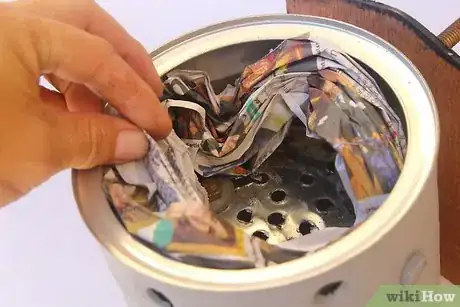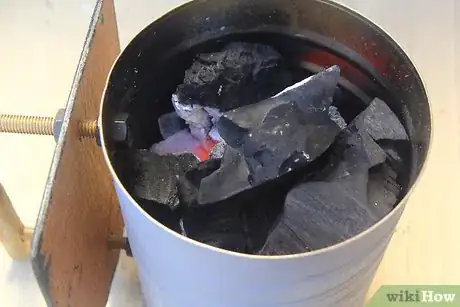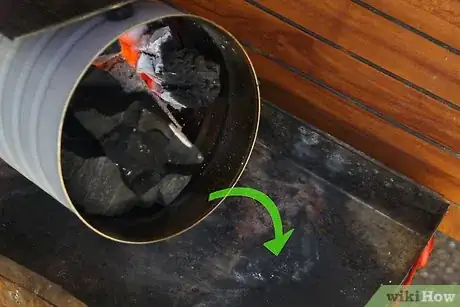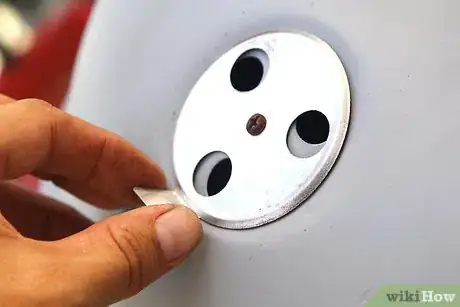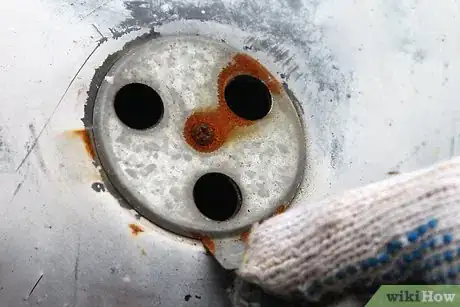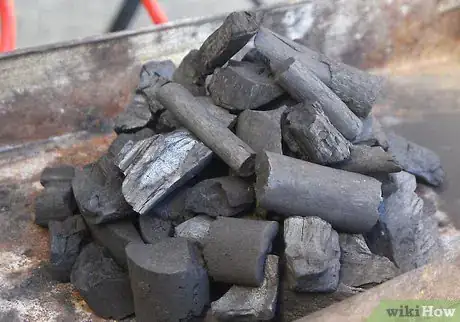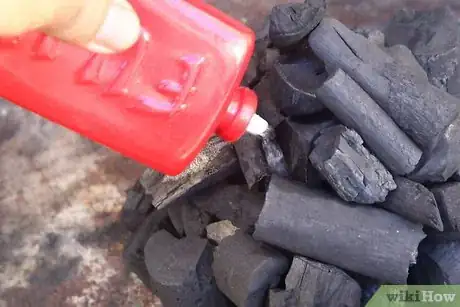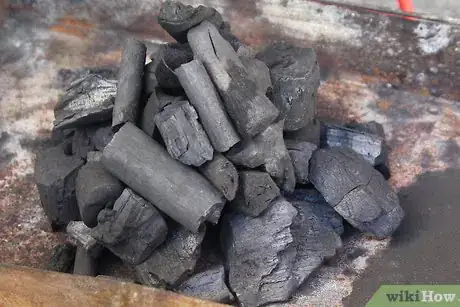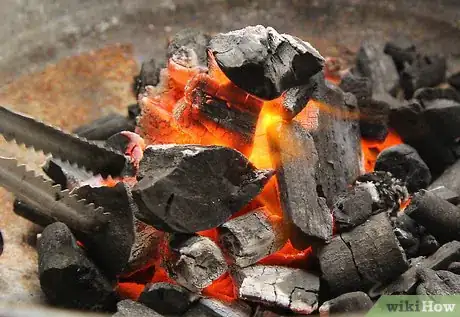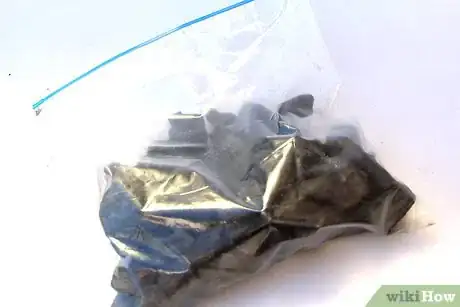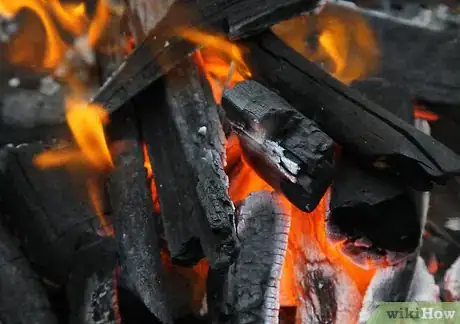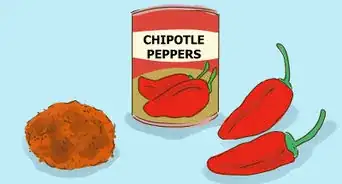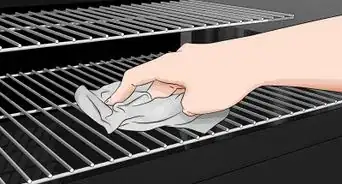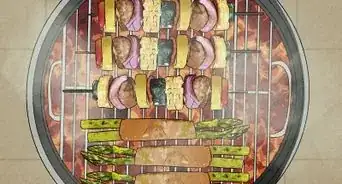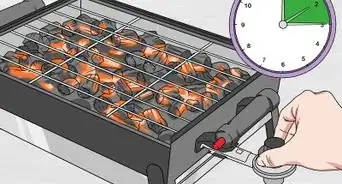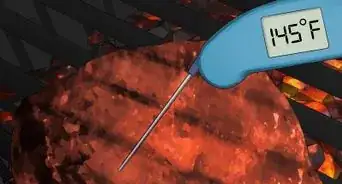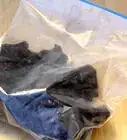wikiHow is a “wiki,” similar to Wikipedia, which means that many of our articles are co-written by multiple authors. To create this article, 23 people, some anonymous, worked to edit and improve it over time.
There are 8 references cited in this article, which can be found at the bottom of the page.
wikiHow marks an article as reader-approved once it receives enough positive feedback. In this case, 87% of readers who voted found the article helpful, earning it our reader-approved status.
This article has been viewed 518,756 times.
Learn more...
It may seem intimidating to start and maintain a strong fire, especially when charcoal is involved. However, with some basic equipment and knowledge of charcoal, anyone can have a professional BBQ going!
Things You Should Know
- Pack newspapers and charcoal briquets in a chimney starter to smoke or cook meat on the grill.
- Squirt lighter fluid on a stack of charcoal briquets to create a traditional campfire look.
- Keep adding coals to your fire so it stays hot as you cook.
Steps
With a Chimney Starter
-
1Use a chimney starter for an even, strong fire with minimal effort. Chimney starters are the easiest way to get a good charcoal fire, and you won't need any lighter fluid, either. You put paper in the bottom, fill the rest of the chimney with charcoal, and light the paper on fire. The heat is contained in the chimney, allowing all the charcoal to quickly catch fire before you dump it onto the grill to use for cooking.
- Chimney starters are usually between $15-$30, depending on size, and can be found online or in hardware stores.
- Most professional BBQ chefs and cooks highly recommend buying a chimney starter, as lighter fluid can influence smoke flavor and is harder to use when making an even heat fire.[1]
-
2Place 2-4 pieces of lightly scrunched newspaper in the bottom of the starter. You only need to ball the paper up loosely, as having it too tight can prevent the flame from getting enough oxygen. The paper will act like a rapid, large match for your charcoal, starting the fire.
- If your chimney doesn't have a solid bottom, place the paper on the charcoal grate of your grill and lower the chimney on top of it.
Advertisement -
3Fill the top of the chimney with charcoal briquets or wood chips. Fill the entire chimney up with your favorite charcoal, or a mixture of both. Use enough charcoal for your entire grill, as the chimney will ensure that everything is evenly lit. For a normal, 22" grill this means roughly 40 briquets, but simply filling your chimney to the top should be a close enough estimate.[2]
-
4Light the paper from the bottom in 2-3 places. Use long matches or a grill lighter to protect your hands. The paper will burn up quickly, but the concentrated flames and hot air will ignite the bottom charcoal, which will then light the rest of the chimney.[3]
- Place your chimney on the charcoal grate of the grill or a heat-resistant surface as it heats up. It will get very hot, and can cause a fire if left unattended.
-
5Dump the coals on the grill the top pieces are covered in gray/white ash. As the heat rises in the chimney, the coals on top will catch and start to coat with white/gray ash. It usually takes 10-15 minutes to get hot enough. You are then ready to start grilling.[4] Dump the coals in the center of the grill if you plan on keeping the whole grill surface hot, or on one-half of the grill if you want separate areas for direct and indirect cooking.
- If you plan to grill for more than a half hour then add several handfuls of charcoal now so that they catch as they others begin to fade..[5]
-
6Make sure the vents are open for a larger fire. Open vents send more air and oxygen to the fire, helping it grow quickly. Keep the lid open as you position the coals and sear anything your want to grill, then close it to smoke the meat or cook it more slowly.
With Lighter Fluid
-
1Open the bottom vents of your grill and remove the cooking grate. Get rid of the cooking grate, set the top aside, and open the bottom vents of the grill. You want as much air as possible to get to your charcoal in order to start an even, strong burning fire.
- Clean out any ash now, as it will smother your fire and keep the charcoal from lighting evenly.[6]
-
2Form a "pyramid" of charcoal briquettes, with the peak in the center of the grill. Aim the opening of the bag into the center of the grill when dumping out the briquettes to naturally form a pyramid. Then use your hands or a pair of long-handled tongs to stack any other pieces of charcoal along the sides on the pyramid. Start with roughly half the number of briquettes outlined below to start your grill. Once it's hot, add charcoal, 5-7 piece at a time, to get the grill up to full strength.
- For a small, portable grill, you want 25-30 briquettes, or pieces of charcoal, when you start cooking.
- For a medium to average sized grill, you'll want roughly 40 briquettes.
- For a large or industrial grill, you will need 1 bag or more of charcoal to cook.[7]
-
3Squirt a small amount of lighter fluid in the center of your pyramid. You don't want to drench your charcoal in the fluid, as it takes a while to burn and will make a thick, unappetizing smoke. Simply squirt the fluid for no more than a count of "2 Mississippi" around the center of the pyramid, trying to get the fluid in the middle.
- You can also start your pyramid, douse the inner briquets with fluid, then pile the "top" of the pyramid above the lighter fluid soaked briquets to make sure the whole pile gets hot.
- A mistake that many grillers make is using too much lighter fluid, which then imparts a petroleum-like tinge to the taste of their food. You do not need a lot of fluid, just enough to get a few pieces of charcoal smoking. These pieces will then help the rest of the pile catch.
-
4Let the briquettes with lighter fluid soak for 2-3 minutes. Do not light the grill immediately. Waiting allows the lighter fluid to soak into the top layer of charcoal, helping it to burn evenly.
-
5Apply a thin second layer of lighter fluid. Lightly squirt the pyramid with a few bursts of lighter fluid in several places, only letting it soak in for a few seconds. This is what will "catch," so you don't want to drown the charcoal in fluid or you risk a dangerous flair up. You just want a few little areas of fluid to start your fire.
-
6Light the fire safely with a long match or electric lighter. Though lighter fluid is not made to flare up, it should still be treated with respect. Light the pile in 2-3 places where you put the lighter fluid, aiming to get the middle of the pile lit where possible. The fire will likely start large, with big flames leaping around the charcoals, but this is just the lighter fluid burning.
- Once the flames die down, the center of the pile should be smoking and developing white/gray coloring. This means your fire has caught.
-
7Spread the briquettes out once they are mostly covered in gray/white ash. Once you can barely see any black, the fire is ready for cooking. The inner coals of your pyramid should be glowing red. Spread the coals in your desired pattern, adding more if you plan on grilling for a long time. As a general rule of thumb, you should add a handful or two of coals every 30 minutes if you plan on continuing to grill.
- You want 1-2 layers of charcoal over your entire grilling area, not patches of charcoal or solitary, exposed coals. Charcoal maintains heat by staying clustered together, much like ice in a pack stays cold longer than separated cubes.
- If you've added charcoal, wait 5-6 minutes for them to catch. Since the heat of the rest of the charcoals is already hot enough, it should not take long.
-
8Seal up any unused briquets for next time. Use a clip to seal the top of the bag if you have leftovers in the bag. The additives in the charcoal will evaporate, making them harder to light next time with or without lighter fluid.[8]
Building and Keeping a Strong Fire
-
1Pack your charcoals together for strong, direct heat. As you cook, use your tongs to keep the charcoals together, as solitary briquettes will quickly lose heat and do little to keep your fire going. You do not want them so well packed that they can't get air, but you also don't want them separated like many little islands.[9] There are two styles of charcoal placement, depending on how you plan to cook:
- Even Grilling: Coat the entire bottom surface of the grill with two layers of charcoal. This allows the whole grill to reach a consistent, even temperature. If you're cooking food quickly and don't need any indirect heat (for large, slow-cooking cuts of meat), this is the way to go.
- Two-Zone Grilling: Shuffle all of the charcoals into an even pile on half of the grill, leaving the other half bare. This lets you cook foods quickly, directly over the charcoals, but also allows you to cook slower cuts by indirect heat on the opposite side of the grill. You can also keep already cooked food warm, on the empty side of the grill, or smoke them with grill top on.[10]
-
2Add coals regularly to keep your grill burning hot. Don't wait until you're almost out of briquets to add more. Instead, add 5-10 pieces of charcoal when you have roughly half of your charcoals remaining, usually every 30 minutes. Wait 5-10 minutes while the new charcoal ignites and begins to get a white/gray coat on the outside before you resume cooking.[11]
- If you feel like you need more coals, add them. More coals mean a hotter burning grill. Add slowly, putting on 5-6 at a time, until your grill reaches your desired heat.
-
3Keep the top and bottom vents open to get the hottest temperature. The more air you get to the fire, the hotter it will cook, so opening the vents is key to a hot, strong burning charcoal fire. The more oxygen you give to the flames. the hotter your grill will be. If you need to control the temperature, close one or both of the vents partially. Closing both of them at once can suffocate your fire and extinguish it.[12]
- Closing the upper vent is also useful for smoking, as it lowers the temperature of the fire and traps the smoke in the grill around your food.
-
4Empty the ash frequently. There is a small lever that lets you open and close the bottom vents on your grill, and this same lever can be used to remove ash through the vents. Ash takes up space for air and will smother the coals as it builds up.
-
5Adding hardwood charcoal for added flavor and greater heat. Wood burns hotter than briquettes, leading to a smokier flavor and an easier sear. It also burns faster than briquettes, however, leading many cooks to use a combination of the two. This allows you to keep the fire burning for longer but still get a hot, smokey fire going to sear steaks or larger cuts or meat.[13]
- Try hickory or applewood charcoal for the best, classic BBQ flavor and a strong fire.
Community Q&A
-
QuestionWhen making a disposable BBQ with an aluminum pan, does covering it with an aluminum cover weaken the temperature?
 Community AnswerYes, covering your fire will smother and extinguish it.
Community AnswerYes, covering your fire will smother and extinguish it. -
QuestionUsed a brick-built BBQ on a hot sunny day with no wind. We lit it using kettle and the ashes were glowing then went white, so we tipped them into grill blade but it went out quickly. What should we do?
 Kevin GioglioCommunity AnswerBe sure there is oxygen to the coals when they are placed on to the grill blade, but you also want to keep the coals in a pile and not have them spread out, or they die out quickly.
Kevin GioglioCommunity AnswerBe sure there is oxygen to the coals when they are placed on to the grill blade, but you also want to keep the coals in a pile and not have them spread out, or they die out quickly. -
QuestionHow can I ensure that all of the charcoal will burn when I light my grill?
 Community AnswerIf you follow the steps in the article, all of your charcoal will burn.
Community AnswerIf you follow the steps in the article, all of your charcoal will burn.
Warnings
- Never spray lighter fluid on burning coals. This can result in severe injury. By following the steps above, you will avoid the need to re-light or supplement the fire.⧼thumbs_response⧽
- Never use gasoline to start a fire. Lighter fluid is designed for slow, controlled fires.⧼thumbs_response⧽
References
- ↑ http://www.bonappetit.com/test-kitchen/cooking-tips/article/the-one-tool-you-can-t-enjoy-fourth-of-july-without
- ↑ http://www.seriouseats.com/2009/04/grilling-lighting-the-fire-without-lighter-fluid.html
- ↑ http://www.savoryreviews.com/2009/05/09/how-to-start-your-grillsmoker-without-lighter-fluid/
- ↑ http://www.seriouseats.com/2009/04/grilling-lighting-the-fire-without-lighter-fluid.html
- ↑ https://www.doityourself.com/stry/how-to-keep-a-charcoal-grill-hot
- ↑ http://www.the-grilling-spot.com/charcoal-grilling.html
- ↑ http://www.extraordinarybbq.com/bbqbasics/charcoal/
- ↑ http://www.the-grilling-spot.com/charcoal-grilling.html
- ↑ https://www.doityourself.com/stry/how-to-keep-a-charcoal-grill-hot
- ↑ http://amazingribs.com/tips_and_technique/2-zone_indirect_cooking.html
- ↑ https://www.doityourself.com/stry/how-to-keep-a-charcoal-grill-hot
- ↑ http://www.the-grilling-spot.com/charcoal-grilling.html
- ↑ http://www.bonappetit.com/test-kitchen/common-mistakes/article/5-mistakes-people-make-when-lighting-a-charcoal-grill
About This Article
To create a strong burning charcoal fire, start by forming a pyramid of charcoal briquettes in the center of your grill and squirting some lighter fluid into the middle of it. Then, let the charcoal soak for a few minutes, apply a little more lighter fluid, and ignite the fire. Once the briquettes are mostly gray and white, spread them out and start cooking. To keep your fire burning strong, add between 5 and 10 more coals every 30 minutes. To learn how to start a charcoal fire using a chimney starter, read on!

